The AOC 24G2 is next in line for our review of the sub $300 USD gaming monitors. The market is just fierce with competition right now from different manufacturers, with AOC aiming to take a good chunk of the real estate with the 24G2.
Now the AOC 24G2 is a gaming monitor with 144Hz of refresh rate featuring a 23.8″ IPS panel with 1ms of response time via back-light strobing. The monitor also comes with AMD FreeSync technology, the Premium one – which is really nice.
Table of Contents:
- 1 Technical Specifications
- 2 Packaging and Accessories
- 3 Design, Layout and Build Quality
- 4 On-Screen Display Menu
- 5 Test Setup and Methodology
- 6 Color Gamut
- 7 Tone Response
- 8 Brightness
- 9 Contrast Ratio
- 10 Screen Uniformity
- 11 Color Accuracy
- 12 Power Consumption
- 13 Button to Pixel Input Lag
- 14 Motion Clarity: MPRT
- 15 Motion Clarity: Pursuit Camera
- 16 Backlight Bleed
- 17 Viewing Angles
- 18 Frame Skipping
- 19 Software, Lighting and Special Features
- 20 Final Thoughts
Technical Specifications
| Display | |
| LCD Size | 23.8″ |
| Aspect Ratio | 16:9 |
| Resolution | 1920×1080 |
| Refresh Rate | 144Hz (Adaptive, AMD FreeSync Premium) |
| Pixel Pitch | 0.2745mm |
| Brightness | 250cd/㎡ |
| Contrast Ratio | 1000:1 |
| Panel Type | IPS |
| Response Time | 1ms (MPRT) |
| Color Space | 125% SRGB, 94% Adobe RGB |
| Color Depth | 8-bit (6 bit + Hi-FRC) |
| Backlight | LED |
| Connectivity | |
| Display Options | 1x DisplayPort 1.4, 2x HDMI 2.0, 1x VGA |
| USB | N/A |
| Audio | 1x 3.5mm (Audio Out) |
| Ergonomics | |
| VESA Mount | 100x100mm |
| Pivot | -90°/+90° |
| Swivel | -30°/+30° |
| Tilt | -5°/+20° |
| Lift | 0-130mm |
| Dimensions | |
| Length | 540mm |
| Width | 47.2mm |
| Height | 322mm |
| Weight | 4.25kg |
Packaging and Accessories
AOC had the 24G2 packed inside the usual monitor packaging. The product should come with the following items inside:
- Power cord
- HDMI cable
- DisplayPort cable
- VESA mounting screws
- Quick start guide
Design, Layout and Build Quality
AOC refreshed their entire line-up this year and the 24G2 is no exception. It features an updated styling which is something the brand needed to keep up with the options from their competitors. There’s less distracting elements to see from this 24-inch display with the red accents acting as a much appreciated highlight rather than an annoyance.
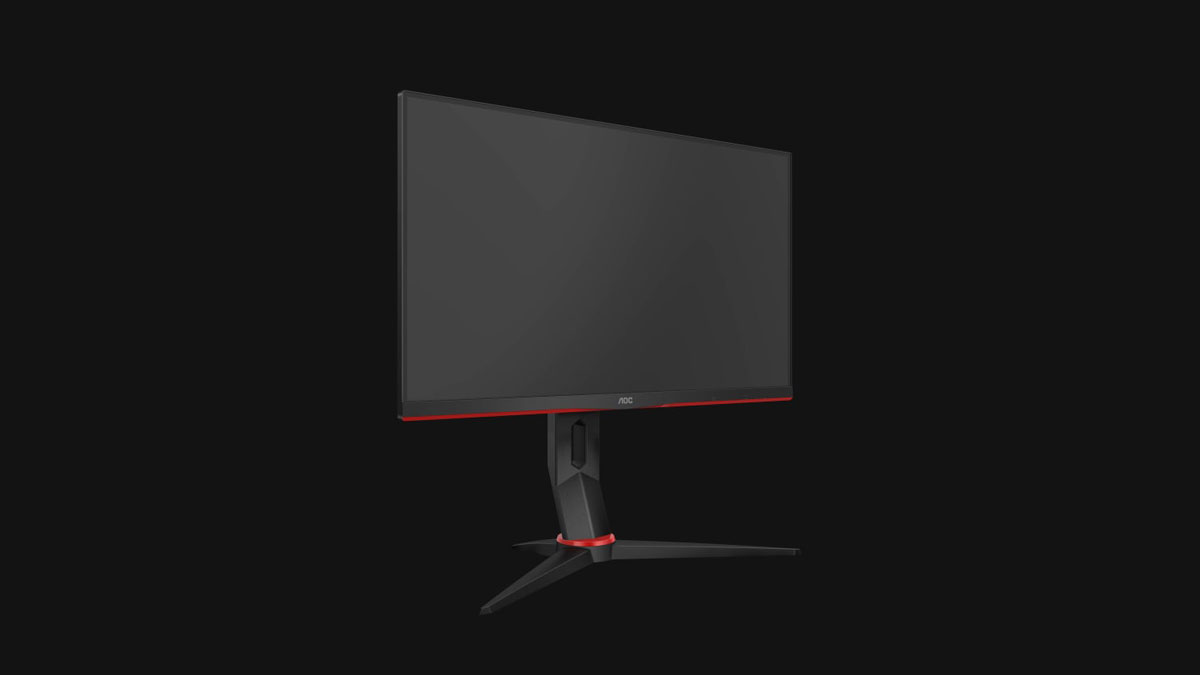
AOC chose a 3H anti-glare coating with the monitor. More matte and less gloss is of course appropriate for environments with tons of light sources. Gamers will also appreciate this blend of coating for less distraction.
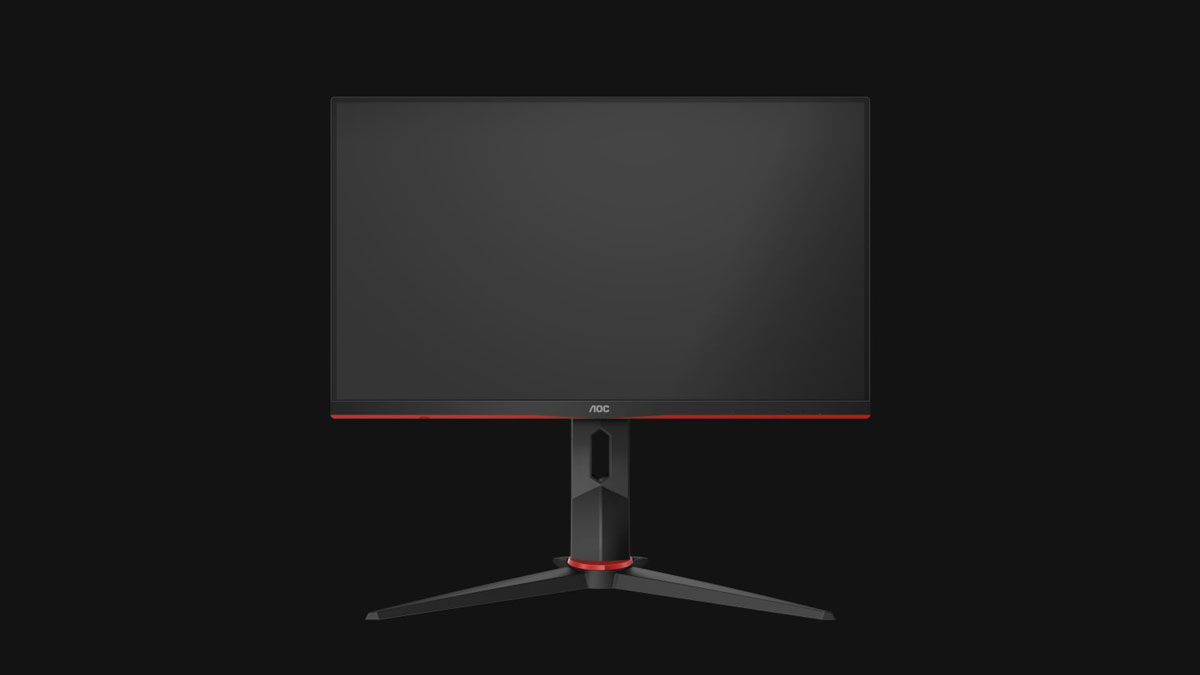
Ergonomically, the 24G2 has a lift, tilt, swivel and pivot options via its updated stand design. A cable route is also implemented – though it is nothing fancy. Still, the monitor supports VESA mounting for extra flexibility.
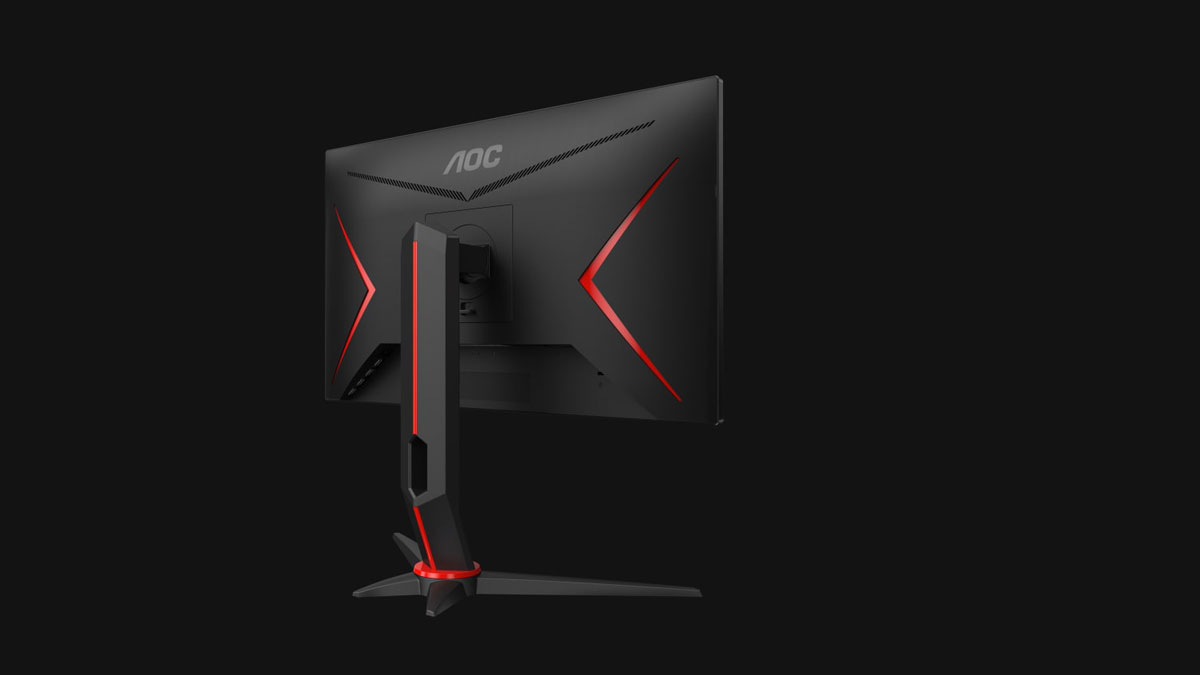
Display options are decent with a surprise VGA port for the most hardcore. We have dual HDMI 2.0b ports here, a DisplayPort 1.4 and a 3.5mm audio-out. Useful, since the monitor doesn’t have a speaker to begin with. A Kensington lock is also a part of the package.
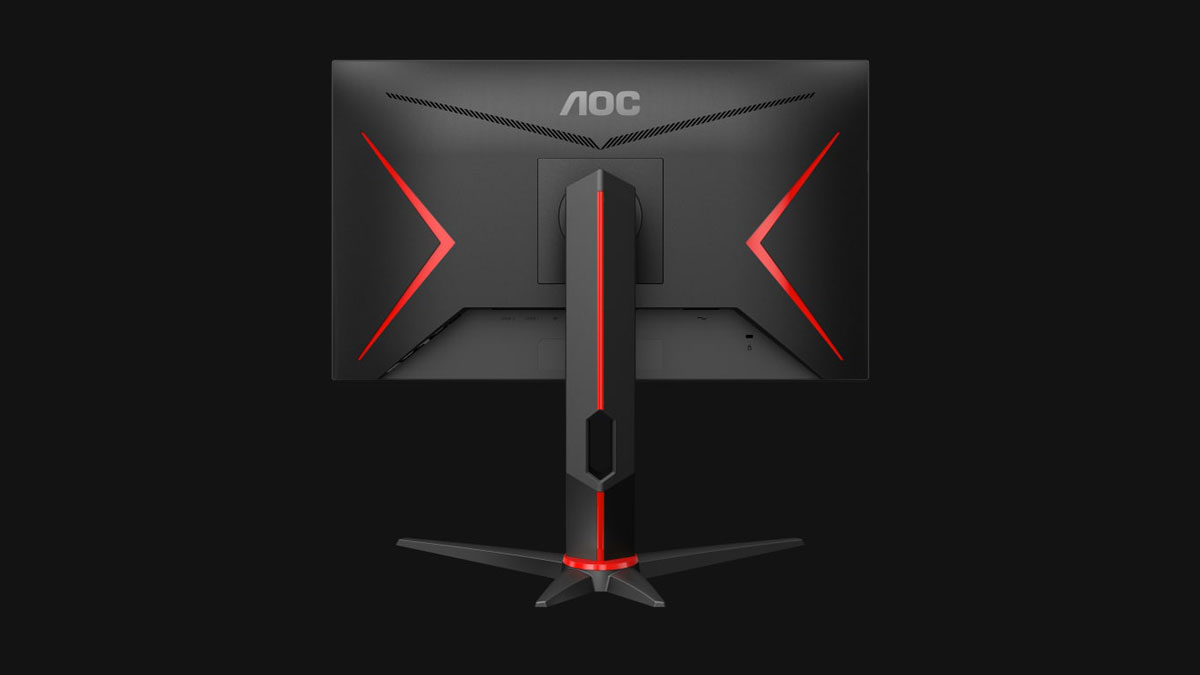
Power is fortunately internal – a plus for those who hates power bricks. Cooling appears to be decent with proper perforations behind the panel.
On-Screen Display Menu
Button layout for the OSD is similar to the ViewSonic XG2405 but with a more user friendly design – something I never thought I’d say for such. We have 8 menus here with no immediate presets to choose from. For that, Eco Mode is what you should use.
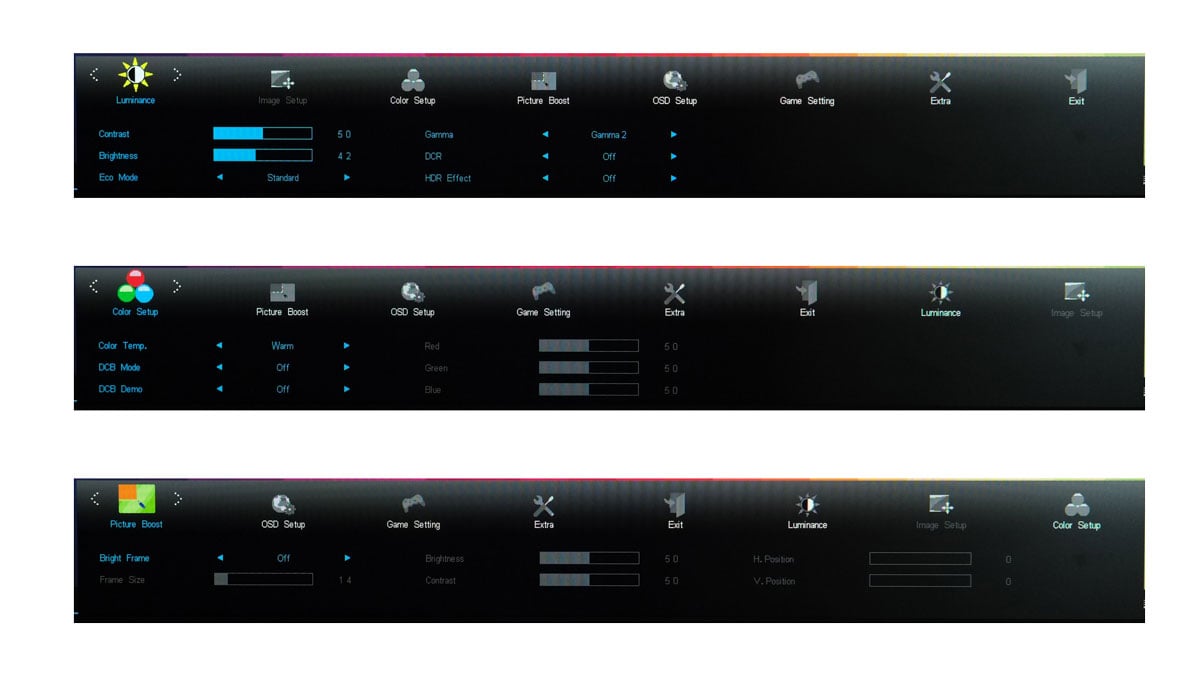
For calibration and standard settings, the Luminance and Color Setup menus are what you should focus the most. In true AOC fashion, we also got adjustable gamma presets here which is always a plus to see.
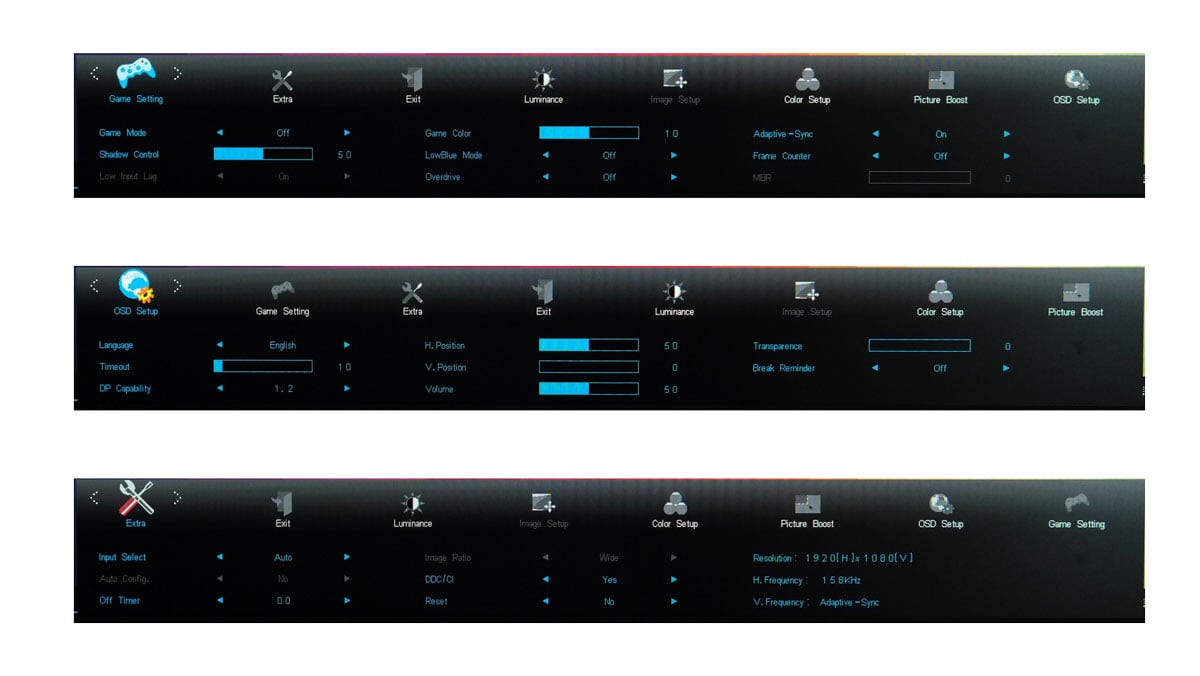
The Gaming Setting menu got its own presets as well, but I find tinkering on my own is best. This is where you’ll find the display overdrive, adaptive sync and strobing options among with a few standard gaming settings.
Test Setup and Methodology
Our test setup relies on the Blur Busters TestUFO Motion Tests and the Data Color Spyder5ELITE Display Calibration System. The cameras used throughout the review for the motion artifact and high speed assessments are the Fujifilm XE-1 and the Nikon 1 J1.
| Test System Specifications | |
| CPU | Intel Core-i5 6600K |
| Motherboard | ASUS Z170-A |
| Cooler | Noctua NH-L9i |
| Memory | ADATA Premier DDR4 |
| GPU | ASUS ROG Strix GTX 1060 OC |
| Storage | Crucial BX200 480GB |
| Case | Thermaltake Core P3 |
| PSU | CORSAIR RM850X |
| Display | DELL U2715H |
| OS | Microsoft Windows 10 Pro |
Target for calibration is a 2.2 Gamma value, with a White Point at 6500K and a Brightness value set at 120 cd/㎡. Calibrated values are then analyzed with the Spyder5ELITE Display Analysis tool. Do note that Dynamic Contrast Ratio and other extra features built within the OSD are disabled during the tests. The following OSD values are selected for the display calibration.
| OSD Settings | |
| Brightness | 42 |
| Contrast | 50 |
| Saturation | NA |
| Temperature | Warm |
| Gamma | Gamma 2 |
| Preset | N/A |
If you wish to use the calibrated ICC profile taken from our Spyder5ELITE result, just send us a message. You may also read our guide on how to use ICC profiles.
Color Gamut
The Color Gamut test evaluates the color space coverage of the display panel from industry standards such as sRGB and AdobeRGB. Higher percentage values are better.
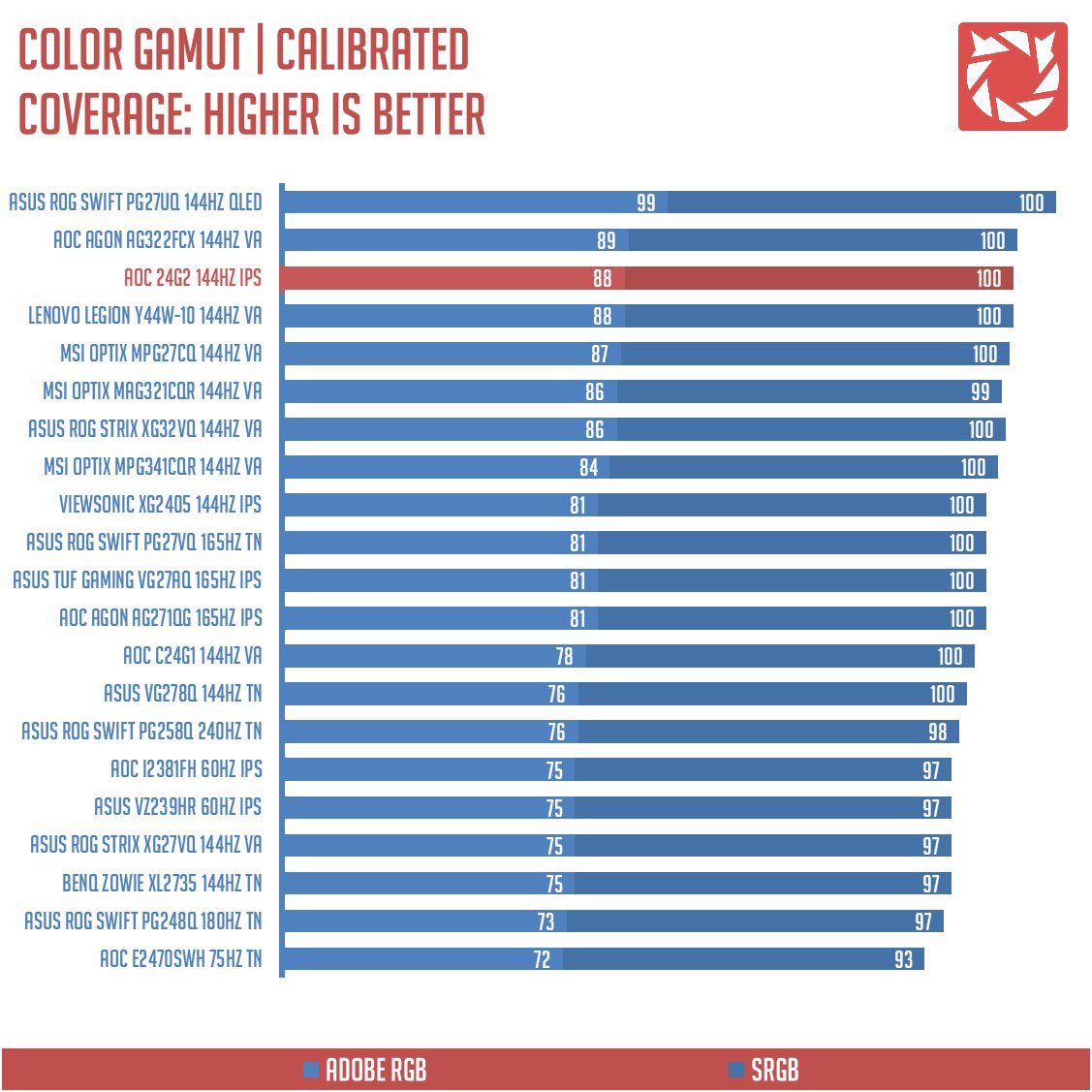
sRGB color coverage is 100%, while we have a 88% coverage for the AdobeRGB color space. Though not in the result, DCI-P3 is about 97% covered.
Tone Response
Tone response is where we check the display panel’s Gamma and presets if there are any. We then compare the results with the industry standard Gamma level at 2.2. Closer to this value is better.
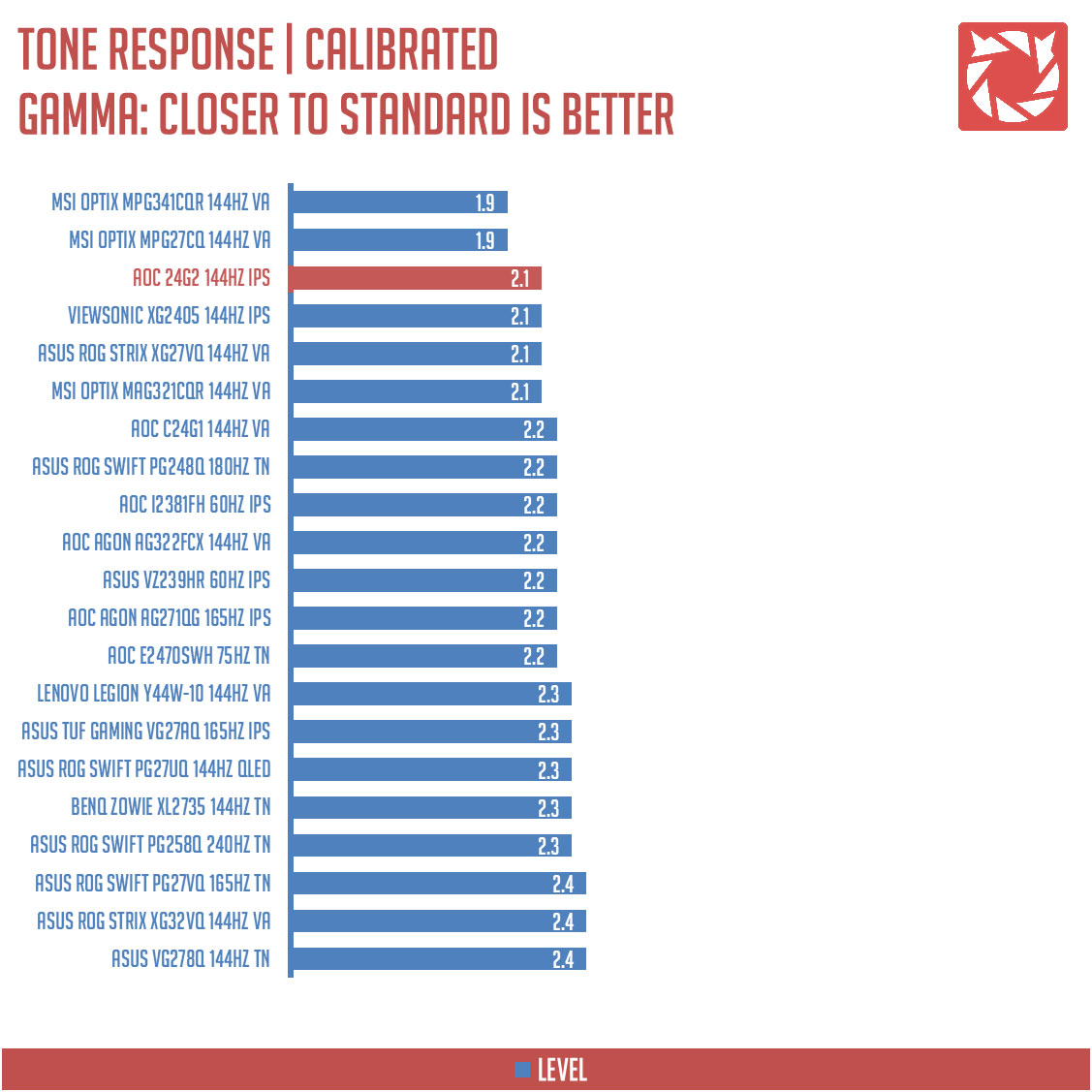
The Gamma value we got from the result is exactly 2.1 at its Gamma 2 settings. Gamma 1 will net you 1.9 while Gamma 3 will net 2.5 on the OSD.
Brightness
The test here will shows us an overview on how the display performs at its maximum brightness level. This is measured in nits or candela per square meter (cd/m2). Higher is better.
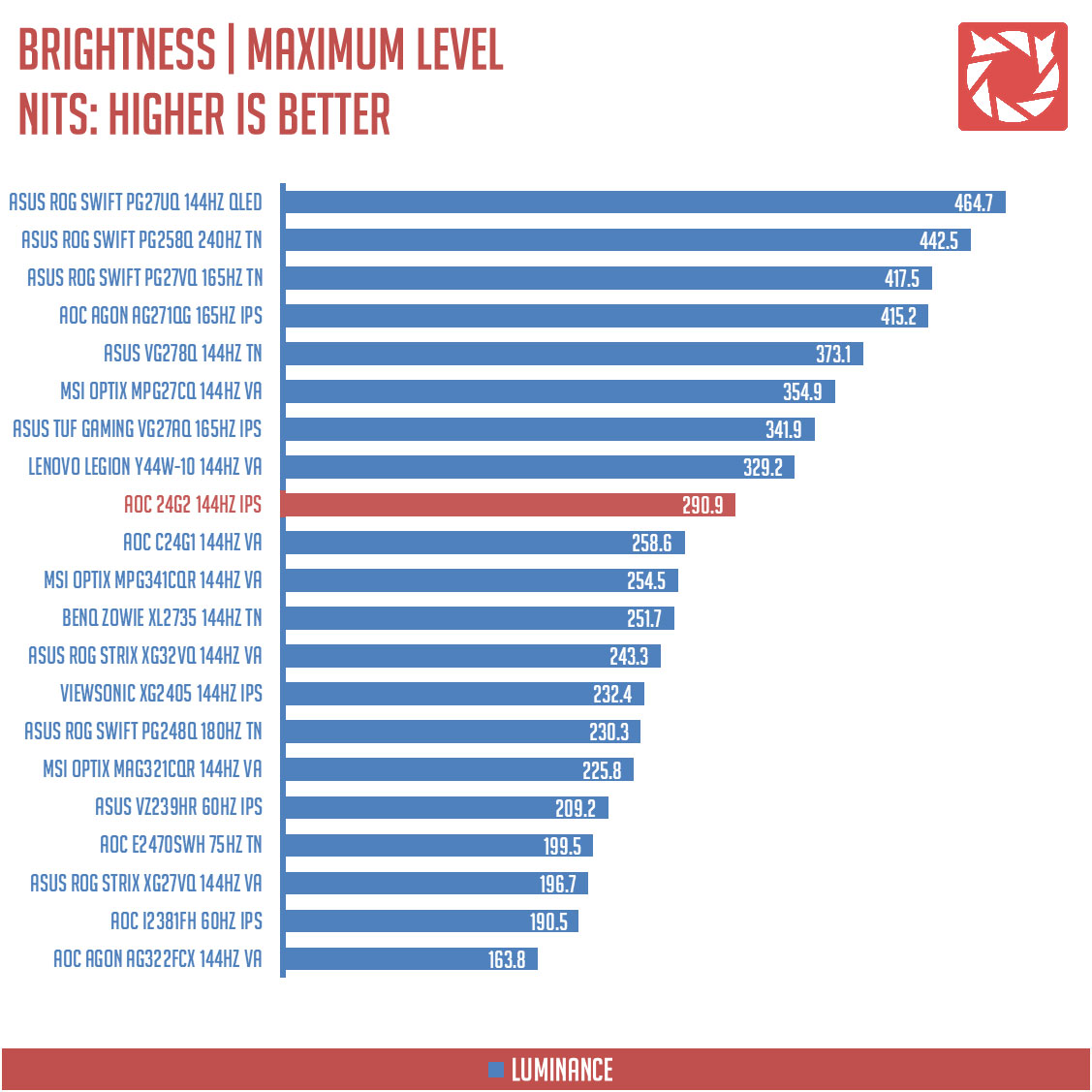
Panel brightness at 100% is rated at 290.9 cd/㎡. Way higher than the rated 250 value from the specifications which is always a plus.
Contrast Ratio
Static contrast ratio is also tested. The test here will shows us how the display performs at its maximum contrast level measured in luminance ratio. Higher is better.
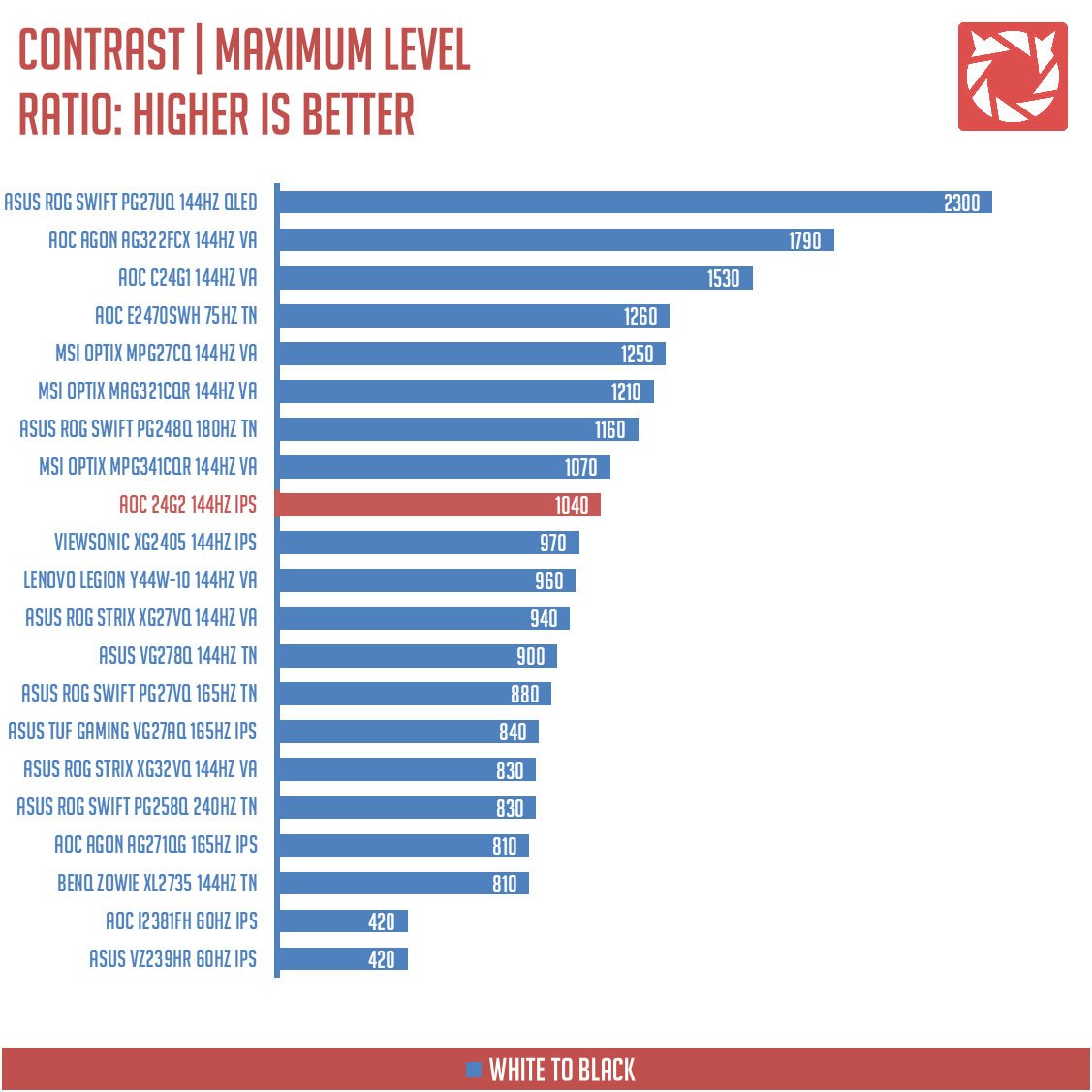
Static contrast ratio is rated at 1040:1. A bit better than the specified which is great.
Screen Uniformity
This test shows us an overview of the display panel’s screen uniformity at maximum brightness level. The closer this value to 0, the better the quality of the panel.
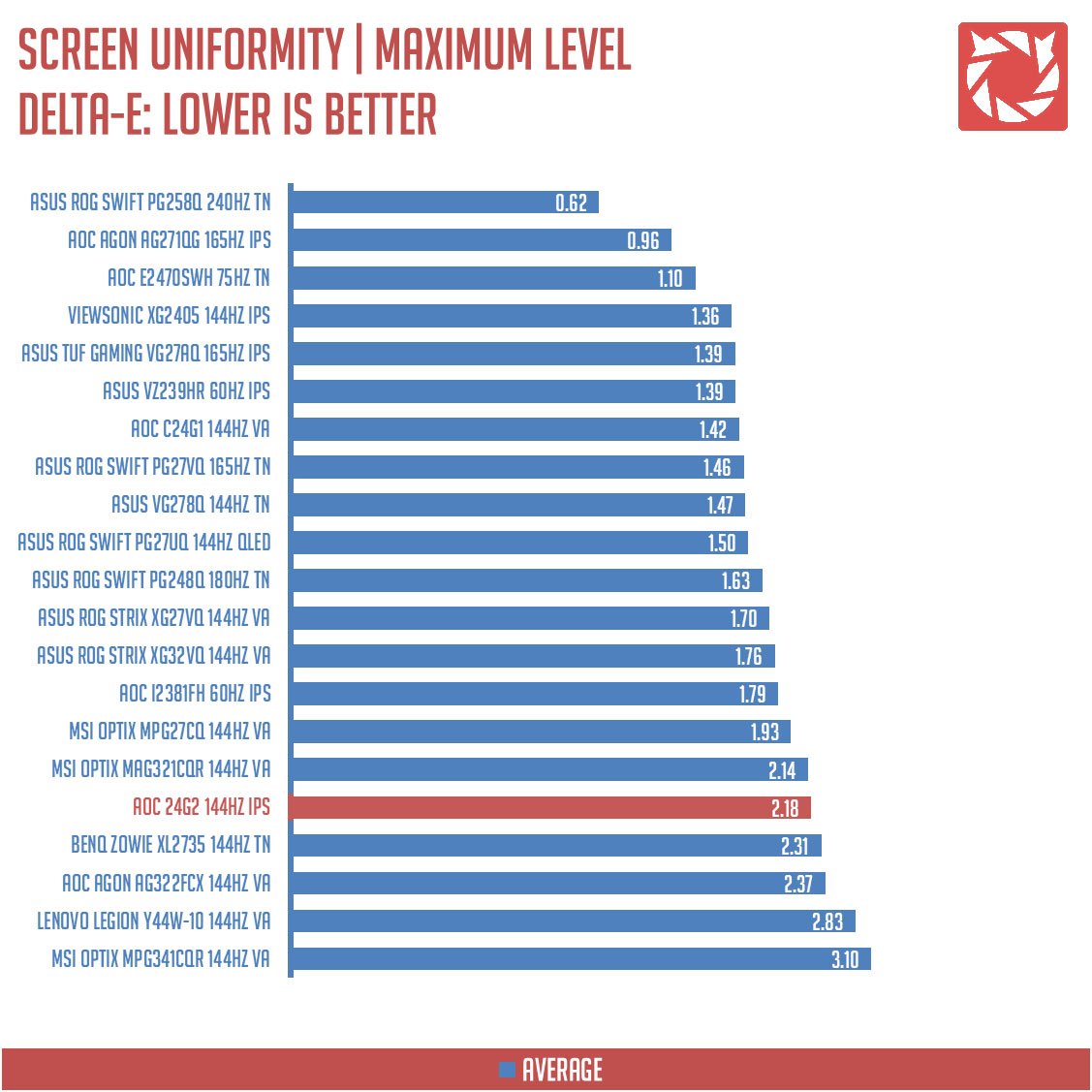
Screen uniformity is where the display kinda failed a bit. The middle-top and top-right most area of the panel are the main culprits here with a Delta-E value exceeding the base line at 4.4 and 4.0.
Color Accuracy
The color accuracy test shows how different basic color hues are reproduced by the display panel. These color tones corresponds with the Datacolor SpyderCheckr. Lower Delta-E values are better.
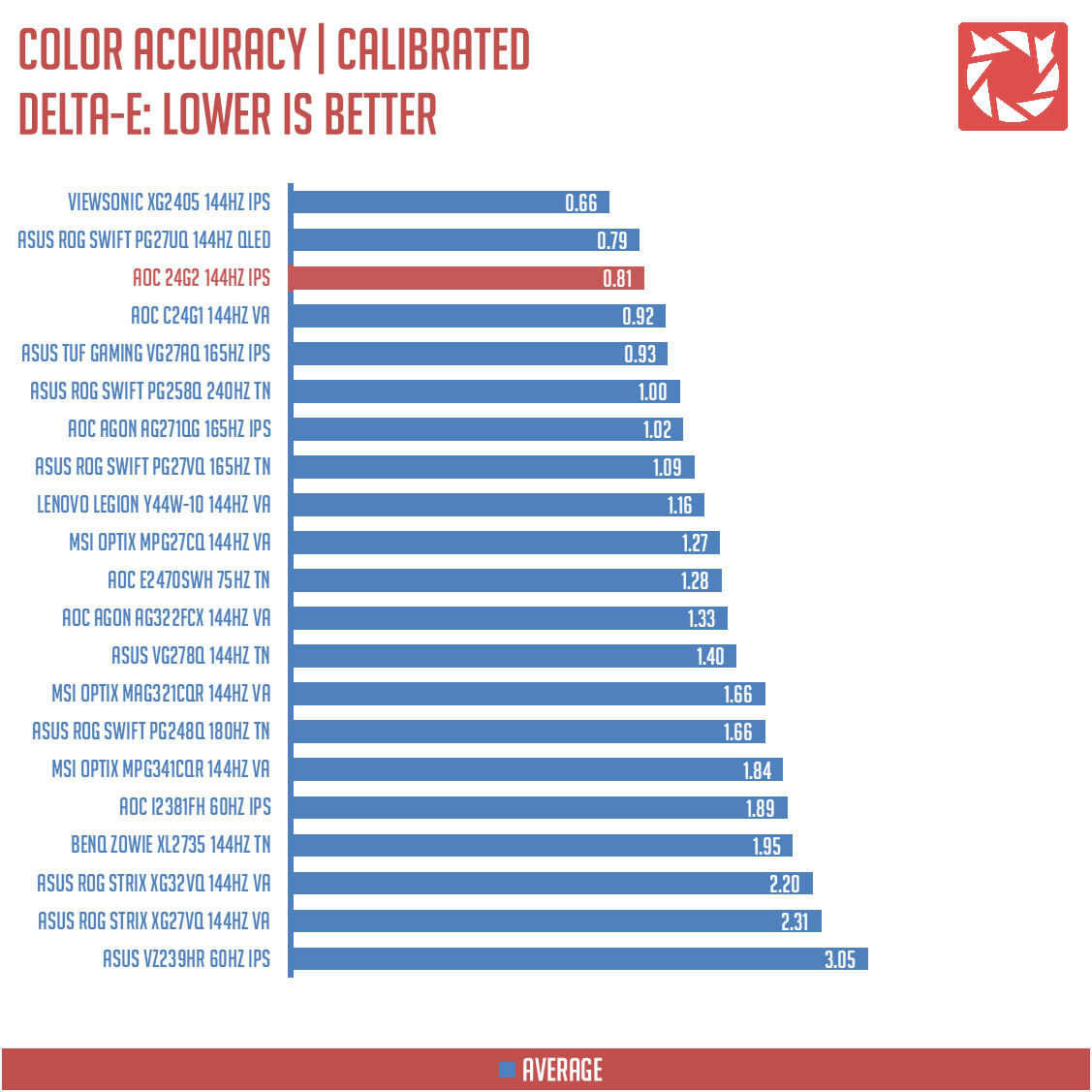
The AOC 24G2 scored an average of 0.81 Delta-E value. Not the best but certainly among the top notchers on our color accuracy test.
Power Consumption
The power consumption is checked with a power meter. Measurements are taken at maximum brightness level.
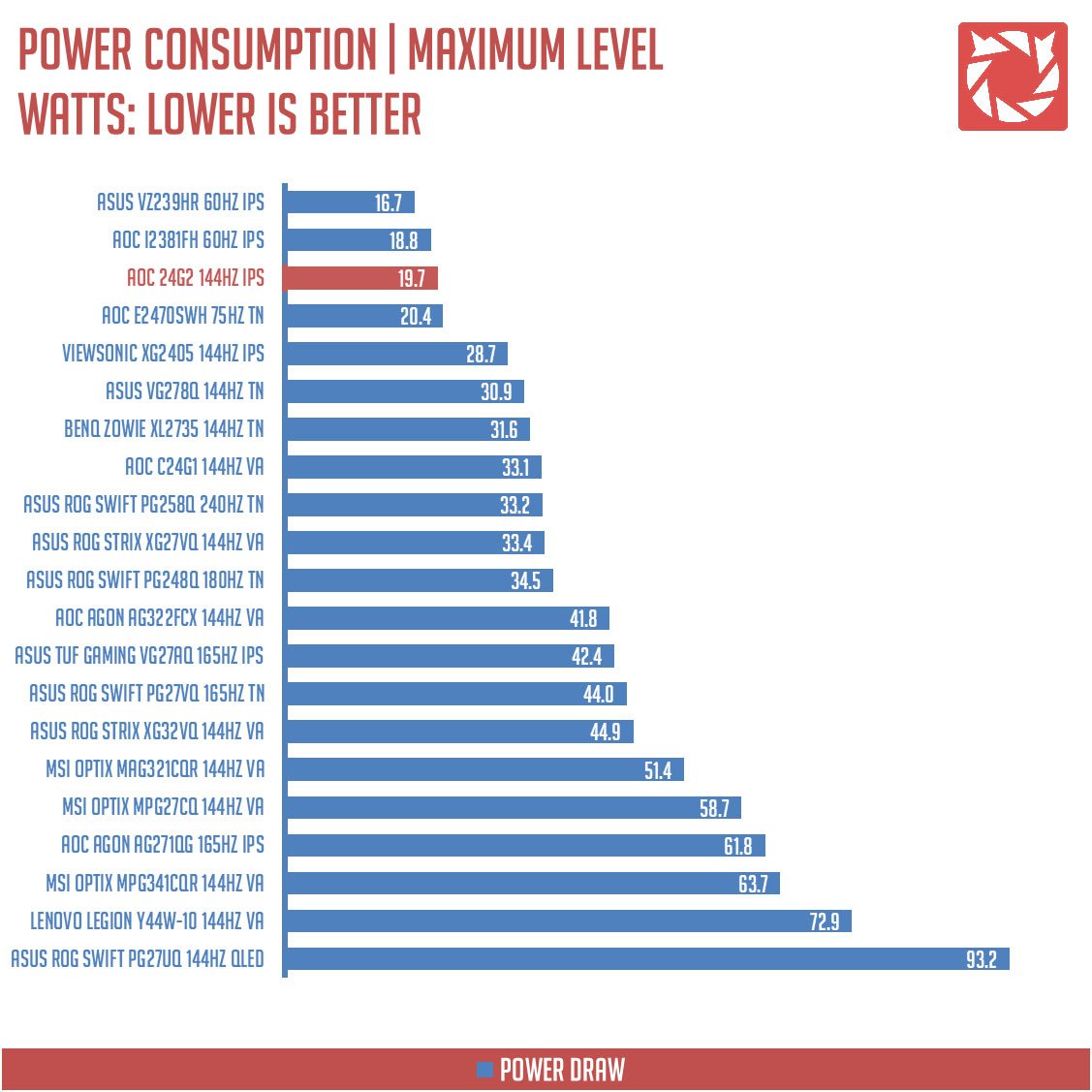
Power consumption is about 19.7W at maximum brightness and contrast which is awesome if we’re going to consider the panel’s maximum brightness level. It easily bested the ViewSonic XG2405.
Button to Pixel Input Lag
Our Button to Pixel Input Lag result is the combination of latency from the point of input, processing and display output. To quantify the display panel input lag, we utilized Quake 3 Arena as our main shooter. The game is set at the panel’s native resolution with the FPS locked at 250. We check how much delay in milliseconds it took the monitor to output the signal via a 1200 FPS high-speed camera with ~0.83ms of accuracy.
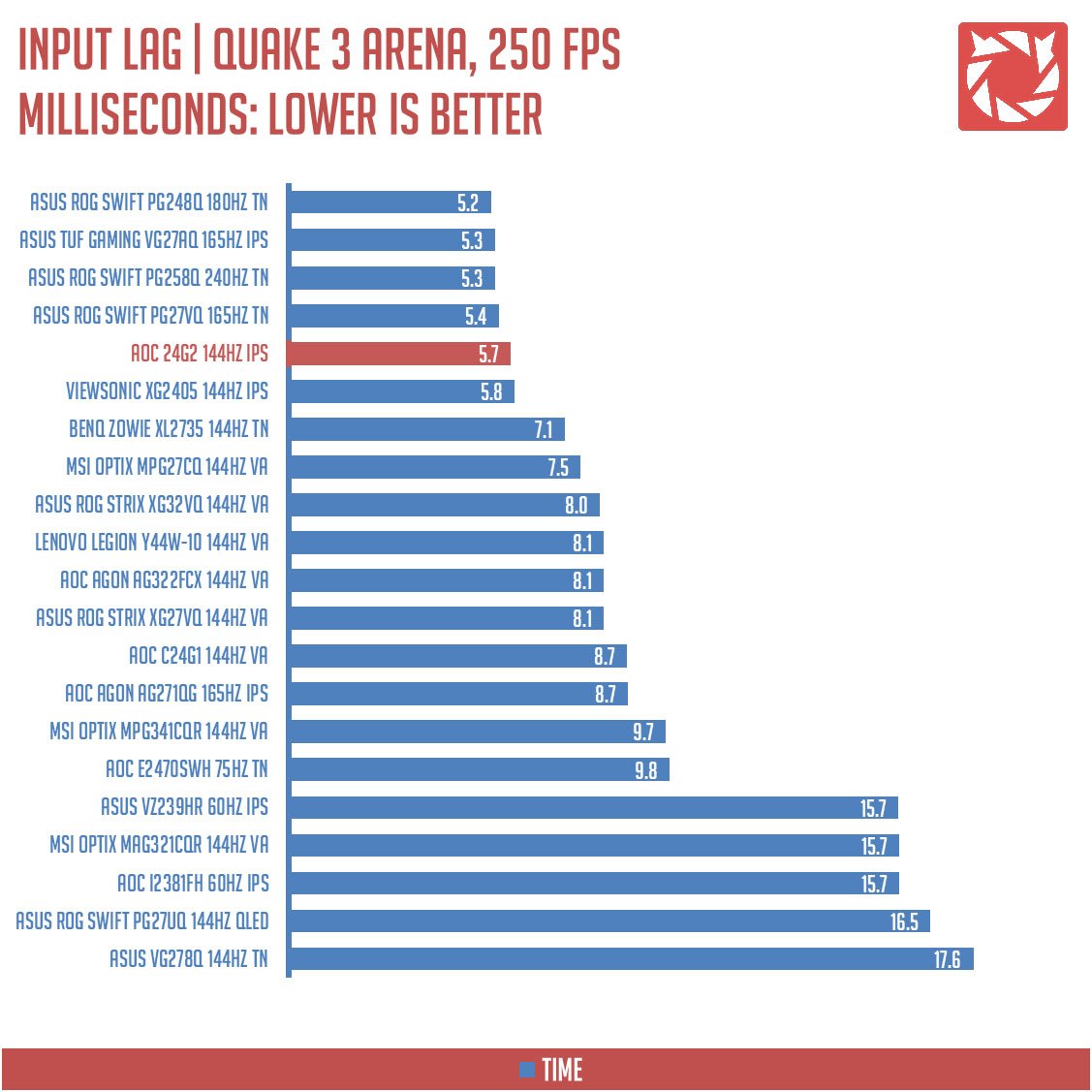
The input lag test result shows that the AOC 24G2 has an average latency of 5.7 ms. The new 5th fastest overall and the 2nd fastest IPS based monitor we’ve tested so far, taking the crown from the ViewSonic model.
Motion Clarity: MPRT
Motion Picture Response Time (MPRT) is the numbered approach to demonstrate the level of perceived motion blur on a display. Basically, a lower persistence value indicates less motion blur. Refresh rate and the sampling method plays a major part here whereas a higher refresh rate nominally features better display persistence values.
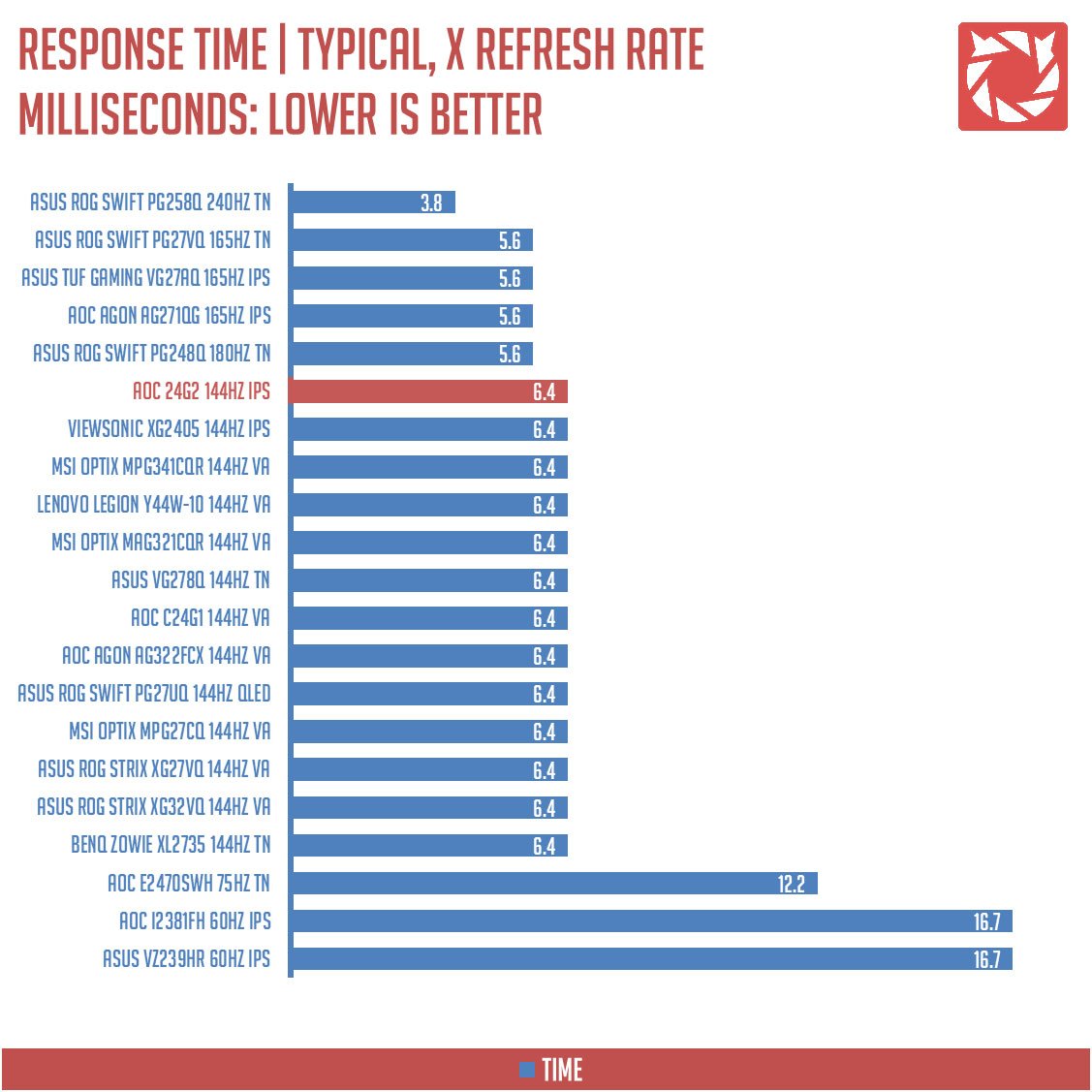
These results are references to check out the theoretical MPRT values of a display. Head over to our Pursuit Camera test for the visual representation of the actual values.
Motion Clarity: Pursuit Camera
Setting up a pursuit camera courtesy of Blur Busters allows us to a great extent, perceive the actual motion clarity of the display. Using such method also allows us to check out motion artifacts including ghosting, inverse ghosting and blurring. This pursuit camera test is a peer-reviewed invention.
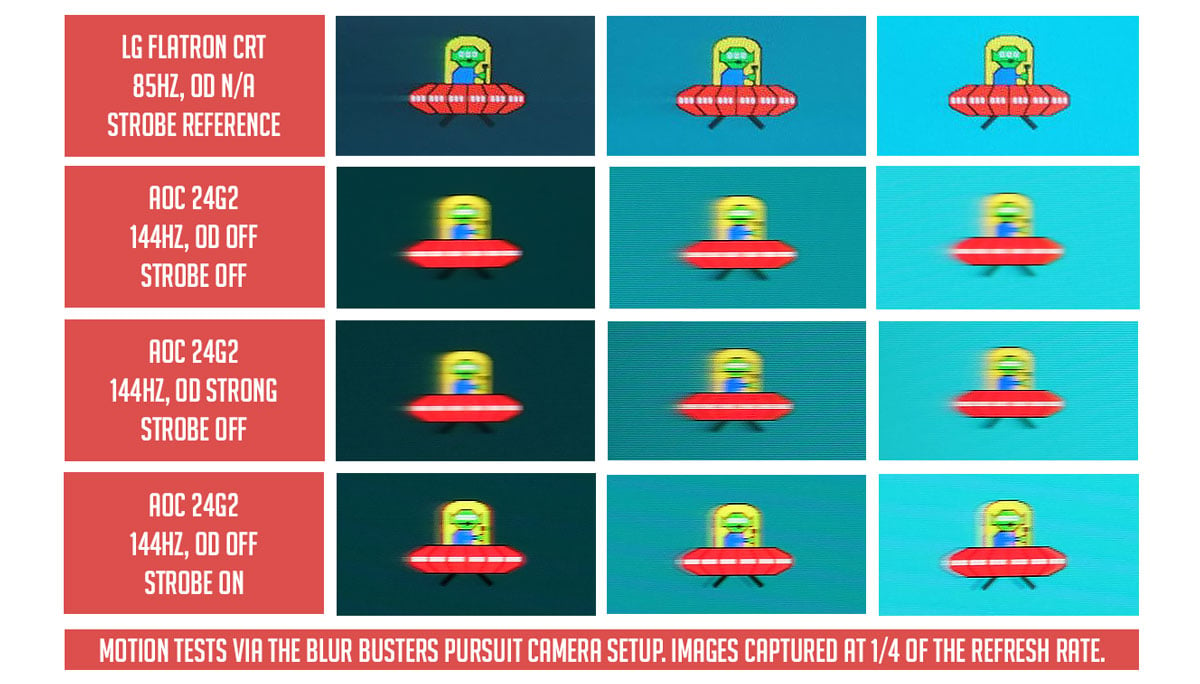
Overdrive at all settings nets almost identical results. Almost, since overdrive at its strongest level gave a bit of advantage when it comes to the clarity of the moving object. Strobing turned on at max MBR nets about ~2ms of MPRT which is not really bad due to an acceptable number of perceived artifacts. Brightness never fall down under 100 nits too at this mode and the fine tuned MBR adjustment could be even used to compensate the fall of brightness.
Backlight Bleed
Backlight Bleed is the phenomenon where backlighting from a display leaks. This is prevalent with LED backlight enabled displays where the LEDs used to light the panel are situated at the edges of the display. Testing the Backlight of the display is conducted on a dim room, simulating the recognizable amount of bleed for such scenario.

Back-light bleed is not a problem with this display. Pretty much uniform around the edges.
Viewing Angles
Viewing angles are also tested to check out how the display panel performs at different positions or eye levels. This should be helpful if you are looking for a panel that could be used on multi-monitor setups.
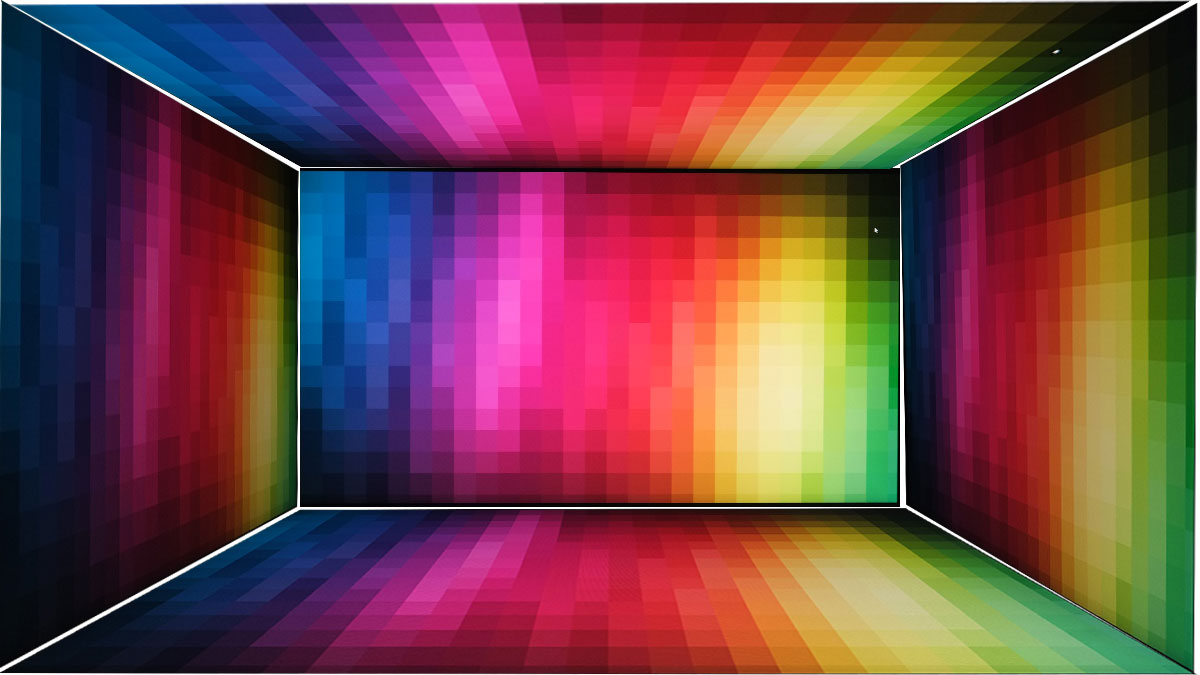
Excellent visual results we got here from the AOC 24G2. Just what I expected from an IPS panel.
Frame Skipping
Frame Skipping is the phenomenon where dropped frames and missing refreshes occur due to ineffective refresh rate overclocking. We are are utilizing the Blur Busters Frame Skipping Checker to test if there is any. If your display exhibits such issues, it should be perceptually similar to in-game frame skipping.
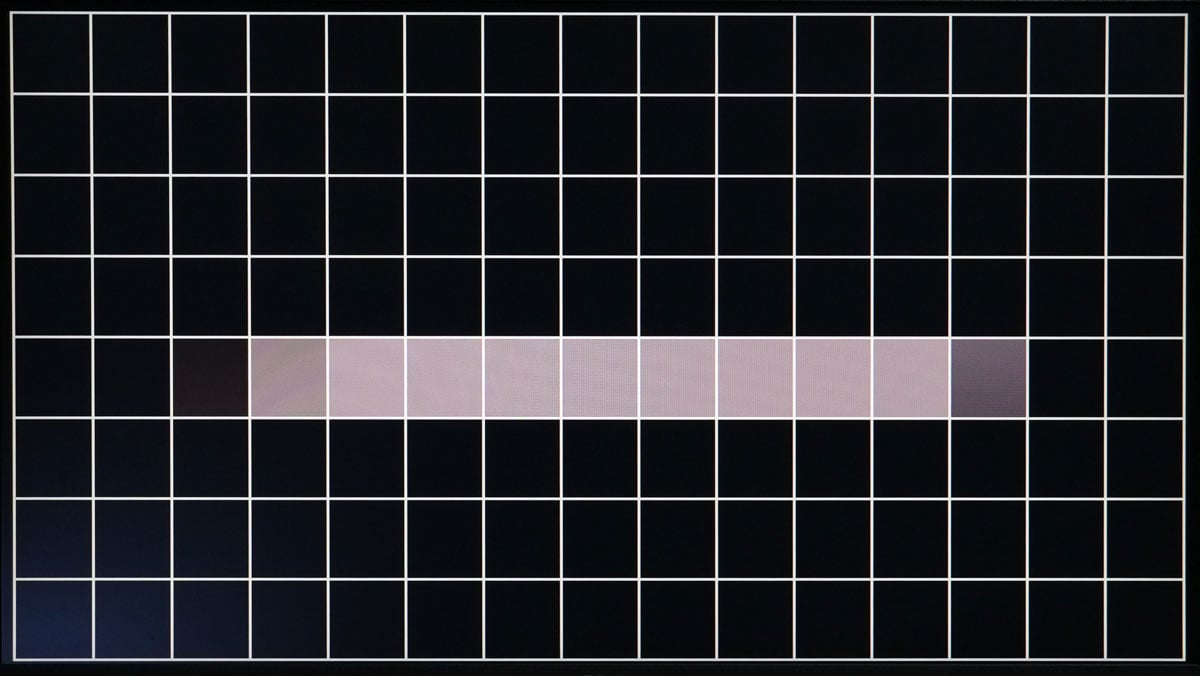
No worries here when it comes to our frame skipping test. Everything’s smooth at 144Hz.
Software, Lighting and Special Features
On top of the 144Hz refresh rate, the AOC 24G2 also supports AMD FreeSync Premium. That said, the display supports Low Framerate Compensation (LFC) with a tested range of 48-144Hz. LFC allows adaptive sync to compensate even if the framerate goes below the scanning rate. Meaning, it alleviates tearing even at low framerate moments.
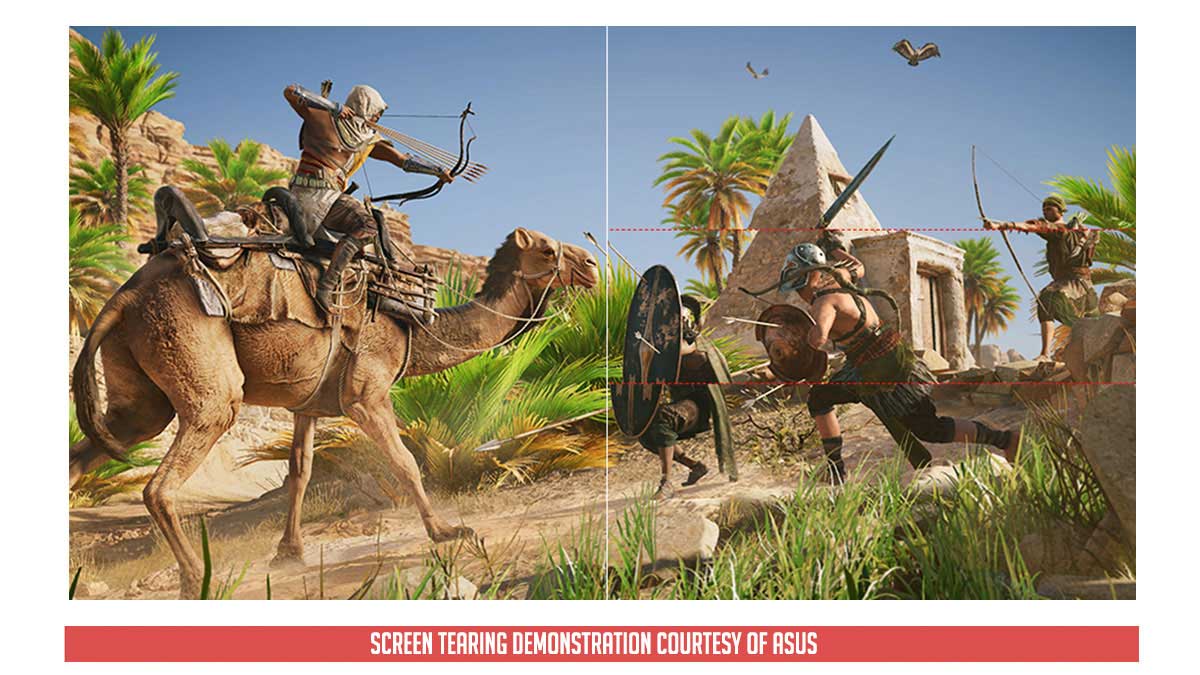
As tested, the gaming monitor comes with back-light strobing in the form of MBR levels. It doesn’t work with FreeSync though so keep that in mind.
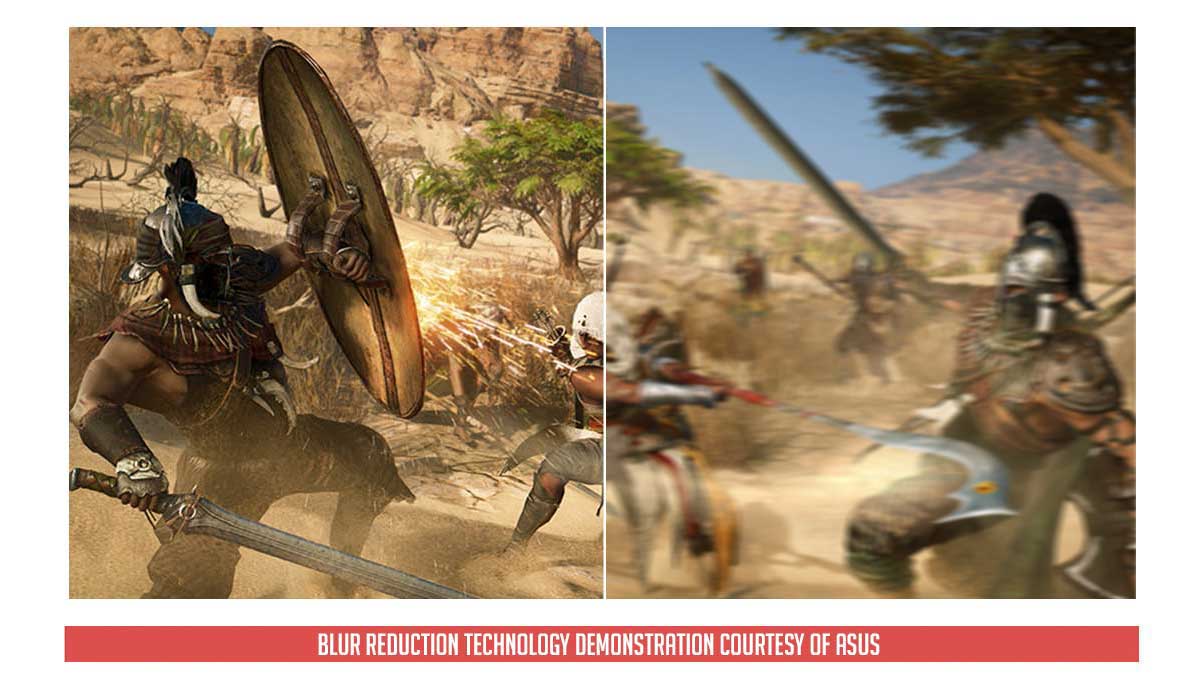
Final Thoughts
We have the XG2405 from ViewSonic and we have the VP24QGR from ASUS. Now, the The AOC 24G2 made it even harder to recommend a 24-inch gaming IPS monitor. It is good, like a really good option at the $200 price point – featuring performance and build quality appropriate even for a monitor over $300 USD.
Performance wise, we are looking at a proper XG2405 contender here. It one upped the display at almost everything with the exception of its borderline decent screen uniformity. A shame it doesn’t have speakers too.
Build quality wise, AOC finally broke the mold with this one – offering better plastics and a stand design appropriate for the ever changing needs of today’s gamers. I felt like AOC is really upping-up the ante for their future products considering the 24G2’s overall build quality and performance.
Coming in hot locally at 11, 100 Pesos, the AOC 24G2 is an excellent 24-inch gaming monitor. No ifs, no buts.
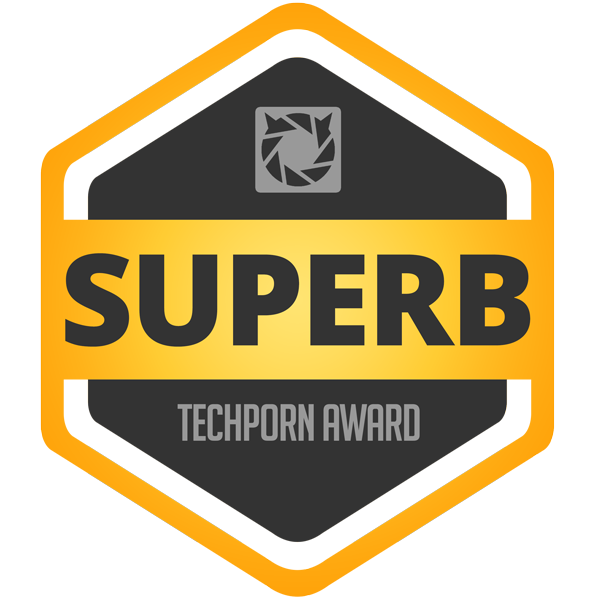
AOC 24G2 Gaming Monitor
-
Performance - 9/10
9/10
-
Build Quality - 9/10
9/10
-
Features - 8.5/10
8.5/10
-
Design - 9/10
9/10
-
Value - 9/10
9/10
Summary
The AOC 24G2 is an excellent gaming monitor with a 24-inch IPS panel at its helm. Quite hard to beat if you care about every inch of performance you could get from it.
Pros
- Best in class performance
- Low input lag
- Back-light strobing with varying levels
- AMD FreeSync Premium
- Decent connectivity options
- Excellent ergonomics
- Thin bezel design
- Excellent power output
- Excellent price point
Cons
- No speakers included (PH model)
- Screen uniformity could be better
- 90’s throwback VGA port
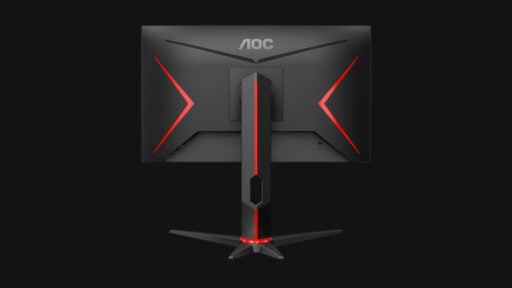
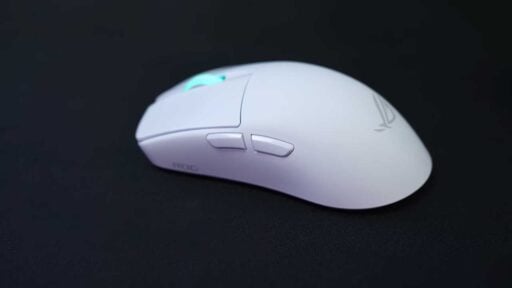

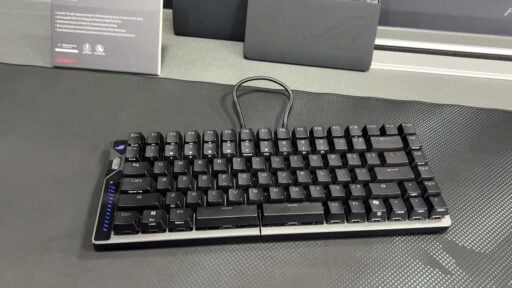
thanku for the AWSM! review i’m convinced now i’m definitely buy this great monitor ;)
Hi ! Maybe you have ICC profile for this monitor, if yes could you share ?
Hello! Great review, I’m torn between XG2405 and this. So it helps me alot what to decide. Can you review also HP X24iH 144hz IPS 1ms?
Thanks! Means a lot :)
As for your request, the HP model is not available in my country – nor I am in contact with HP to request a sample.
This is a video obout it https://www.youtube.com/watch?v=RdM6edIIV6I
So which one would you recommend between the AOC 24G2 and ViewSonic XG2405? I’m conflicted between the two
Both are great buys but as far as the local units are concerned, the XG2405 has a speaker. If that matters, then you might want to pick that up over the AOC model.
Hello! I would like to have the ICC profile used to do some testing.